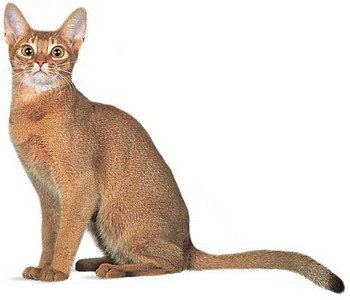


Abyssinian Cat Breed: History, Temperament & Health
History Of The Abyssinian:
The Abyssinian's coat is a perfect camouflage in North Africa's sunburned habitat. The founding cats were brought to Britain from Abyssinia (now Ethiopia) in the late 1860's and accepted in 1882. The breed was almost extinct in Britain in the early 1900's, but by the 1930's it was established in the U.S. Today it is the fifth most popular breed in North America.
Common Abyssinian Health Issues:
Gingivitis
Psychogenic Alopecia: Abnormal hair loss that can be caused excessive self grooming. Similar to obsessive cumpulsive disorder in humans, Psychogenic Alopecia is caused by stress in your cat. This stress can be caused by other cats in the same house, people whom the cat dislikes, and/or separation anxiety. If your cat had an early history of abuse, he may also be prone to psychogenic alopecia. Treatment can include antidepressants, or simply separating the cat from its stressful environment. Or, you can attempt to enrich the cat's environment with toys, climbing equipment, providing a room with a view, even installing a fish tank. Be sure to determine first though, if your cat's alopecia is psychological and not caused by parasites, ringworm, pregnancy, or a hormonal imbalance.
The Abyssinian's coat is a perfect camouflage in North Africa's sunburned habitat. The founding cats were brought to Britain from Abyssinia (now Ethiopia) in the late 1860's and accepted in 1882. The breed was almost extinct in Britain in the early 1900's, but by the 1930's it was established in the U.S. Today it is the fifth most popular breed in North America.
Common Abyssinian Health Issues:
Gingivitis
Psychogenic Alopecia: Abnormal hair loss that can be caused excessive self grooming. Similar to obsessive cumpulsive disorder in humans, Psychogenic Alopecia is caused by stress in your cat. This stress can be caused by other cats in the same house, people whom the cat dislikes, and/or separation anxiety. If your cat had an early history of abuse, he may also be prone to psychogenic alopecia. Treatment can include antidepressants, or simply separating the cat from its stressful environment. Or, you can attempt to enrich the cat's environment with toys, climbing equipment, providing a room with a view, even installing a fish tank. Be sure to determine first though, if your cat's alopecia is psychological and not caused by parasites, ringworm, pregnancy, or a hormonal imbalance.
The Abyssinian At A Glance:
Place Of Origin: Ethiopia (Formerly Abyssinia)
Dates Of Origin: 1860's
Average Weight Range: 9-16 lbs.
Temperament Of The Abyssinian: Attention-demanding.
Breed Colors Of The Abyssinian: Ruddy, red, blue, or fawn in ticked tabby (No other colors are officially accepted).
One of the top 10 most popular cat breeds.
Place Of Origin: Ethiopia (Formerly Abyssinia)
Dates Of Origin: 1860's
Average Weight Range: 9-16 lbs.
Temperament Of The Abyssinian: Attention-demanding.
Breed Colors Of The Abyssinian: Ruddy, red, blue, or fawn in ticked tabby (No other colors are officially accepted).
One of the top 10 most popular cat breeds.
The Abyssinian's "ticked" coat pattern is due to a gene that gives each hair several dark bands evenly spread on a lighter background. Although Abyssinians are often almost silent, their personalities are far from quiet-they are natural athletes, climbers, and investigators. Occasionally they can suffer inherited forms of retinal atrophy, a form of blindness.
One of the top 10 most friendly cats.
Pet Meds: Dogs | Pet Meds: Cats | Dog Health : By Breed | Cat Health : By Breed | Dog Grooming | Cat Grooming | Pet Top 10's | Pet Food Recipes
Pet Meds: Dogs Pet Meds: Cats Common Dog Health Issues Common Cat Health Issues Dog Grooming Cat Grooming Pet Top 10's
Pet Health:Home
Copyright 2006-2011 PetMedsOnline.Org
